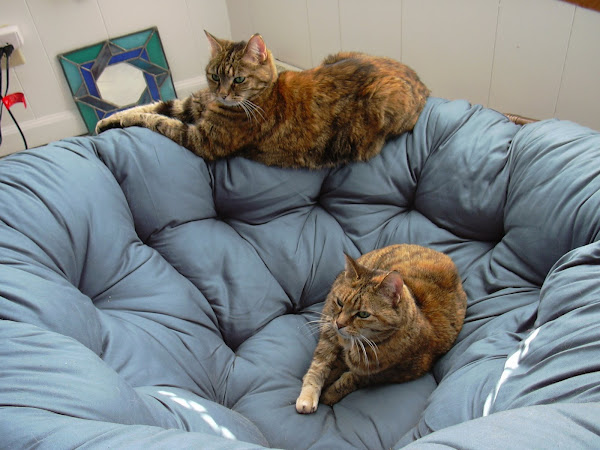C'mon, who got the Monty Python reference? (Tracy . . .?)
Friday late afternoon I had my first steel drum class! Yay! I've wanted to learn to play steel drums for years. Okay, maybe not as long as the lady in class who said she first wanted to learn steel drums after watching an episode of Sesame Street in the 70's. But a long time. I walked in the orchestra room, saw the drums set up, and thought, "Yes! Time to live the dream!"
There are 8 students: me, a mom and her son and daughter (who look to be ten and twelve or so), a high school viola player, a woman who's maybe in her 50's, a woman who's in her 60's, and a boy who's 8 or so. The teacher (I've already forgotten his name-- whoops) explained the different kinds of drums and then assigned us to what we'd play for the evening.
Steel drums are set up kind of like an orchestra. The lead drums are the little ones that people think of most when they hear steel drums played, and they play the melody. They're like the violins. Doubles are, well, double the size of leads, and one person plays two drums (as opposed to one person playing only one drum). The viola player and I played doubles. Our job was to play chords to go with the melody the lead drums played. Next biggest are the triples, which are 3/4 the size of a full drum (oil drum, that is, which is what steel drums are). They're kind of like the cellos in an orchestra. The mom and her son played the triples (they each played two drums at once). The woman in her 60's got to play the bass drums-- all six of them. She got the biggest mallets and the coolest rhythms. I hope we get to trade off once in a while so we get to play all the drum types.
Problem: The bass drums are almost the same height as me. I may never get to play them. Boo!
The teacher said he's never going to give us actual written out music to play. He clearly knows music, but he said the point of this class is to have fun, not to focus on learning to read music (several class members don't have much musical background). He taught us to play a scale and a couple of arpeggios, and then he taught us a song based on a C-scale progression and some rhythms.
Good thing the drums have the notes labeled so you hit the right note at the right time.
Good thing we played slowly.
Good thing I can memorize patterns quickly.
See, the way you get notes on a steel drum is that there are little dings hammered out in different spots. There are two octaves (almost three) on each drum or set of drums. The notes aren't next to each other, though, like on a piano keyboard. They're kind of all over the place. Octaves are near each other, but I can't figure out the rest of the pattern. I'm just memorizing where to hit the drum to get the notes I want.
Other things I learned:
Don't hit the drum too hard or you get a "bark" rather than a ringing tone.
You have to figure out the best spot (the teacher called it "finding the sweet spot") to hit to get the note you want.
Keep your thumbs on top of the mallets and your wrists loose.
Keep your elbows in (kind of sounds like using a portkey).
If you miss a note, just come back in at the right spot and nobody will know you messed up (except the teacher).
Not everybody has a sense of rhythm.
I like how the teacher would sort of chant out the rhythm he wanted us to play. He had a cowbell that he would hit with a mallet to give us the general rhythm, but he would also say it to try to get us to feel it. Several people had a hard time pushing the beat (does no one sing or play jazz anymore?). Our teacher is very patient and he laughs a lot.
Friday afternoons are going to be FUN!!



















 Note the irritation in my expression. It's not that I don't love my toy. I REALLY LOVE my toy. I don't know why; it just calls to me. I carry it around the house, meowing gleefully the whole time. I cannot peacefully sleep without it near me. It reminds me of the primeval need to swallow fur. I bring it to Mom to show her my carefully evolved hunting skills. If she would just let me outside, I could bring her something with REAL fur. Maybe even feathers. Sometimes she throws it and I humor her and pretend to chase it. I bring it with me to the bathmat while Mom showers she knows she is safe in the presence of a sabre toothed tiger descendant.
Note the irritation in my expression. It's not that I don't love my toy. I REALLY LOVE my toy. I don't know why; it just calls to me. I carry it around the house, meowing gleefully the whole time. I cannot peacefully sleep without it near me. It reminds me of the primeval need to swallow fur. I bring it to Mom to show her my carefully evolved hunting skills. If she would just let me outside, I could bring her something with REAL fur. Maybe even feathers. Sometimes she throws it and I humor her and pretend to chase it. I bring it with me to the bathmat while Mom showers she knows she is safe in the presence of a sabre toothed tiger descendant.























